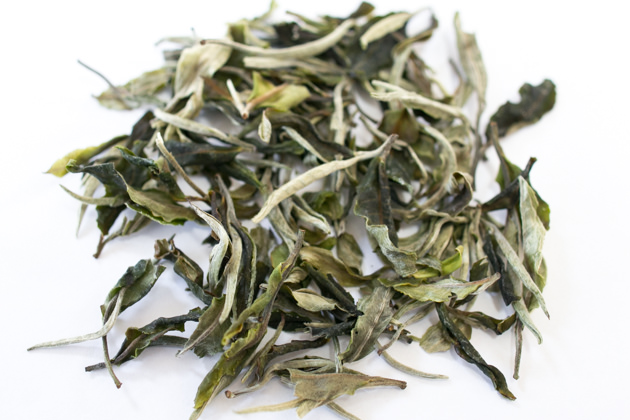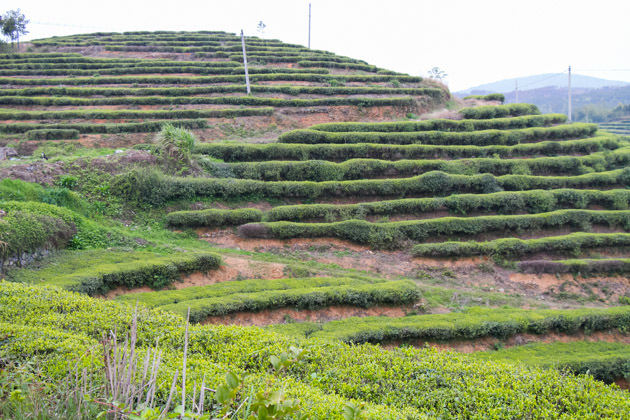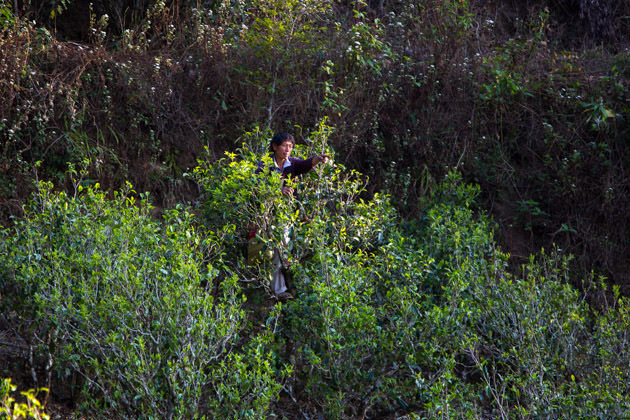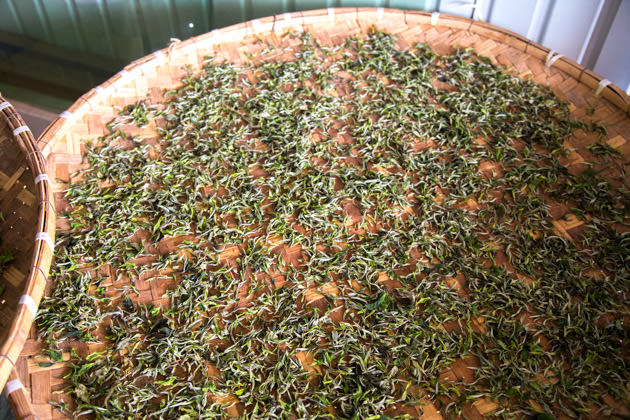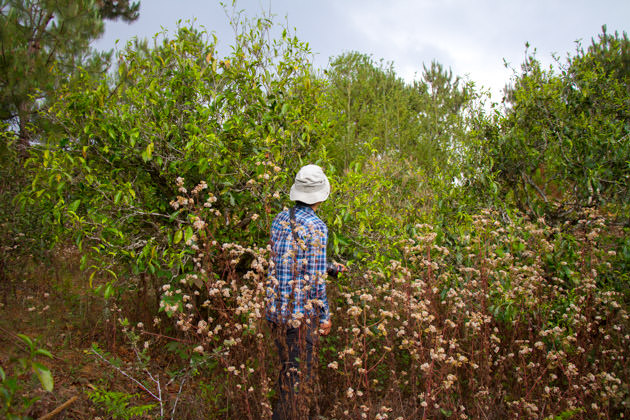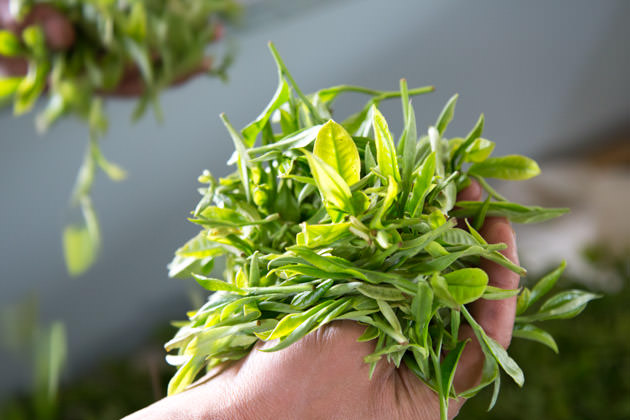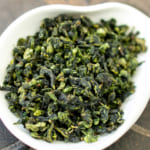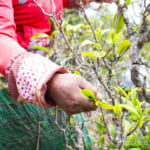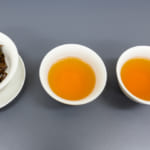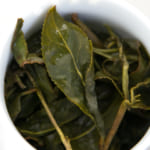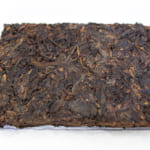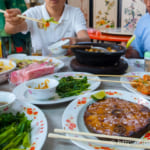- HOME >
- New Arrival at HOJO Online Shop
New Release of Bai Mu Dan Made From Yunnan Tea
- [2018.07.31] Posted By Akira Hojo
We made special white tea, Bai Mu Dan, using tea collected from old tea trees which naturally grown at very high elevation in Yunnan. This tea may give you pleasant surprise that breaks the image of ordinary Bai Mu Dan.
Scenery of where we collected tea
We have chosen Yunnan tea for making white tea
In China, the Fuding county of Fujian province is the biggest production area of white tea. In recent years, due to the increasing demand of white tea, the price of Fuding tea has been over speculated. In the last 10 years, the price of white tea has increased more than 10 times. This situation was triggered because of the trend of aging the white tea for further maturation like the pu-erh tea. As the price goes higher, more and more tea gardens start using fertilizers. Eventually the taste of tea becomes lighter and less long-lasting.
Under the circumstances, we wanted to find the alternative source of white tea. Throughout our years of tea expedition, we noticed that Yunnan was the ideal place to find the tea with excellent quality.
This is the ordinary tea garden in Fuding county
Quality material is a key for the quality of white tea
In Yunnan, there are a number of old tea trees grown at high altitude. However, not all tea gardens practice traditional farming method. In particular, those renowned tea production areas often follow the modern agricultural method. The tea trees are trimmed and grown with fertilizer to make a better output. Eventually, tea quality decreased. Only if we are willing to spend a lot of time exploring around and searching for the garden, we can possibly find the ideal material from the tea gardens with completely natural-farming style (without any fertilizer or pesticide), and some of the very old tea trees that grow as high as two storeys building.
We particularly looked for the garden that is completely free from fertilizer and pesticide. In fact, we are not only concern about the chemical fertilizer but also avoiding any types of fertilizer including the organic fertilizer. The organic garden sounds nice but it does not give the good effect to the tea quality because once fertilizer is used, the growing speed of tea tree becomes faster and the quality decreases.
Process of making tea is often uncertain in Yunnan
Although the quality of the fresh tealeaf is outstanding in Yunnan, the management of the process remains uncertain. In Yunnan, the process is generally not well-managed. In particular, the more remote place we go, the higher the quality of material but lesser attention is paid on process.
Many people often think that making white tea is very simple and it is nothing special but just drying the fresh tealeaf under the shade. The fact is without proper management in process, the tealeaf easily turns black. There are many crucial factors affecting the quality of the white tea, e.g., the temperature of withering process, ventilation, the thickness of tea leaves and etc. Once tealeaf turns dark, it develops specific flavour reminiscent of dried black fungus or mushroom.
Now we are able to produce white tea by ourselves
About three years ago, we have decided to shift the production of loose white tea to Yunnan. Spending a few years’ time, we have searched for the ideal source of material and conducted series of experiment to optimize the process. We studied each processing parameter and optimized each step of the process.
Now our strength is that we are able to produce the white tea by ourselves with the material we particularly selected and follow the quality standard we set. So, we do not need to depends on the manufacturer who normally targeted the mass production for commercial market.
Naturally-grown tea from very high altitude
We selected one bud and one leaf from tea trees grown at high mountain around 2100m in the South West of Lincang, Yunnan. We waited until May to get this tea because we particularly wanted the tealeaf from old tea trees. The first plucking of these teas was only available in May.
No heat is used for making Bai Mu Dan
There are a few styles in making white tea. In Fujian, the white tea undergoes the final drying process with hot air in order to bring up the sweet scent and at the same time, to reduce the greenish note. However, we wish to minimize the usage of heat so as to maximize its natural floral bouquet. Therefore, our Bai Mu Dan only undergoes natural withering process without further heating. It gives multi-layer of refreshing floral note with soft and smooth drinking sensation.
We recommend our Bai Mu Dan not only for the customer who likes white tea but also for those who has never tried white tea. This tea performs excellently not only brewing in hot water but also in cold water.
Since it was the first year that we produced Bai Mu Dan, we did not produce a very large quantity. So, if you like to try this tea, please order it soon. With refer to the sales speed of this tea in Japan when I released earlier, the quantity might not last until the end of this year.
Related Articles
How to get the latest update on HOJO Tea?
1. Follow Twitter, 2. Click "Like" on Facebook, and 3. Subscribe in newsletter. You can have the latest tea news from HOJO Tea.
 Subscribe the Newsletter to enjoy the privileges
Subscribe the Newsletter to enjoy the privileges- You may receive a free sample upon purchase, or you may have the priority to purchase special products. So please remember to subscribe our newsletter as well as the social network.
- New Release of Anxi Traditional Oolong
- Anxi, located in Fujian province, China, is celebrated for its Tie Guan Yin tea. However, the Traditional Anxi Oolong from this region boasts a unique fruity aroma, distinguishing it from Tie Guan Yin. Anxi: A Renowned Hub for Oolong Tea Production in China Fujian Province, renowned for its rich tea heritage, boasts several prominent tea-producing …
- New Release of Lan Yun Tie Guan Yin from Anxi
- Lan Yun Tie Guan Yin from Anxi, is not just an ordinary Tie Guan Yin. It has a strikingly delightful flavor reminiscent of orchid flowers with silky-soft drinking sensation. Anxi, renowned as one of the three major Oolong tea production regions in China. Anxi is recognized as one of the three major Oolong tea-producing regions …
NEW ARTICLES
 New Release of Anxi Traditional Oolong
New Release of Anxi Traditional Oolong- Anxi, located in Fujian province, China, is celebrated for its Tie Guan Yin tea. However, the Traditional Anxi Oolong from this region boasts a unique fruity aroma, distinguishing it from Tie Guan Yin. Anxi: A Renowned Hub for Oolong Tea Production in China Fujian Province, renowned for its rich tea heritage, boasts several prominent tea-producing …
 Yunnan 2024 Spring Tea Sourcing
Yunnan 2024 Spring Tea Sourcing- Yunnan Province is globally renowned for the exceptional quality of its tea leaves. However, lax production management often presents challenges in achieving the desired tea quality when relying solely on pre-made teas. To address this issue, we have committed to remaining on-site throughout the spring season to closely monitor tea production. We are meticulously inspecting …
 The Relationship Between Greenness of Tea Leaves and Fertilizer
The Relationship Between Greenness of Tea Leaves and Fertilizer- For both tea and vegetables, there’s a common misconception that a deeper green colour indicates better quality and greater health benefits. However, this isn’t always the case. Natural plants often have a yellowish-green hue rather than a vibrant green. If you observe wild plants in grasslands or along roadsides during spring, you’ll notice that they …
 Creating Muscatel Black Tea Using a Unique Blending Method
Creating Muscatel Black Tea Using a Unique Blending Method- I would like to introduce the unique creation of black tea with a distinctive muscatel flavor profile. Acquiring Exceptional Mi Xiang Black Tea Have you ever heard of a unique black tea called “Mi Xiang Black Tea” or “Muscatel Black Tea”? This tea is crafted from leaves that have been delicately nibbled by leafhoppers, resulting …
 New Release of Lan Yun Tie Guan Yin from Anxi
New Release of Lan Yun Tie Guan Yin from Anxi- Lan Yun Tie Guan Yin from Anxi, is not just an ordinary Tie Guan Yin. It has a strikingly delightful flavor reminiscent of orchid flowers with silky-soft drinking sensation. Anxi, renowned as one of the three major Oolong tea production regions in China. Anxi is recognized as one of the three major Oolong tea-producing regions …
 The Difference Between Fermentation in Tea and Fermented Foods
The Difference Between Fermentation in Tea and Fermented Foods- Black tea and oolong tea are often categorized as “fermented teas,” but the extent to which they undergo fermentation raises questions about whether they truly qualify as fermented foods. In this article, I endeavour to offer a thorough exploration of the distinctions between tea and traditional fermented foods, shedding light on the nuances of their …
 Easy Way to Prepare Flavorful and Warm Tea at the Workplace
Easy Way to Prepare Flavorful and Warm Tea at the Workplace- Have you ever experienced the transformation of tea stored in a thermos or water bottle at work, turning into a brown hue and acquiring a bitter, astringent taste? As this has piqued the interest of many, I would like to offer a more in-depth explanation for a solution. Tea stored in a thermos undergoes oxidation …
 The new release of Bao Dao Shan Da Cha Tou Brick 2017, exclusively crafted from Da Cha Tou leaves
The new release of Bao Dao Shan Da Cha Tou Brick 2017, exclusively crafted from Da Cha Tou leaves- Bao Dao Shan Cha Tou Zhuan 2017 is a ripe pu-erh tea crafted into brick form. Bao Dao Shan is the name of the mountain situated in the southwestern part of Yunnan. “Cha Tou” denotes a distinctive type of ripe pu-erh tea. In the course of fermenting spring tea, certain tea clumps naturally develop, known …
 We released Lapsang Suchong Qi Zhong Classic: Premium Lapsang Souchong
We released Lapsang Suchong Qi Zhong Classic: Premium Lapsang Souchong- Lapsang Souchong is one of the earliest known black teas distinguished by a unique production method and flavour profile. Its origins are often linked to the Wuyi Mountains in China’s Fujian province, where Lapsang Souchong is traditionally crafted. Black tea production in the Wuyi region has a history dating back several centuries. Lapsang Souchong tea …
 Regular Consumption of Umami Seasoning Can Influence Taste Preferences
Regular Consumption of Umami Seasoning Can Influence Taste Preferences- Excessive consumption of artificial condiments, such as umami seasonings, is believed to influence one’s taste and preferences. I’d like to share my own view to explore how an overabundance of condiments can indeed influence one’s palate. Umami Seasonings Are Prevalent in Asian Countries I spend half of the year living abroad, particularly in China and …
Shop Info

Address:Lot No. T-215, 3rd Floor, The Gardens Mall, Mid Valley City, Lingkaran Syed Putra, 59200 Kuala Lumpur
Tel: +603-2287-4537
Business Hour: 10am to 10pm
Category
- New Arrival at HOJO Online Shop
- Featured Articles
- Newsletter
- Types of Tea
- Origin of Tea
- Teapot and Tea Equipment
- Tea Column
- How to enjoy tea
- Tea Processing
- How to choose quality tea
- Tea constituents and functional effect
- Safety of Tea
- Foods
- Tea Business Operation
- Hobby and Outdoor Activity
- Ranking of Tea
- Video
- FAQ
- Media Release
Profile

- AKIRA HOJO
- I invite you to experience my tea selections.I was born in Nagano, Japan. In university, I studied agricultural chemistry, and I have the master degree in food science. I worked in Japanese food industry for 10 years. I involved in R&D, QC and QA. As a factory manager, I implemented ISO9000 series and managed the factory.
- The Art of Tea Magazine
- We posted the article on “The Art of Tea Magazine No.9, the magazine is published in Taiwan. We featured some scientific view about the tetsubin
- New Straits Times
- The Malaysian National Newspaper, New Straits Times featured HOJO Tea on 17-Oct-2007.

